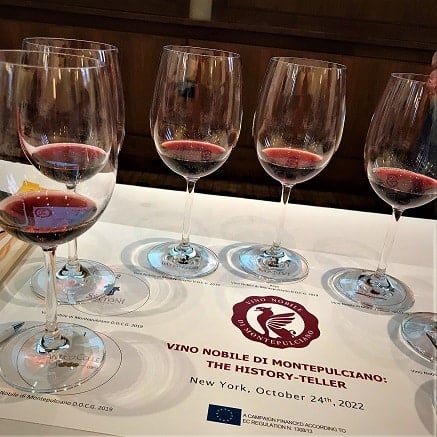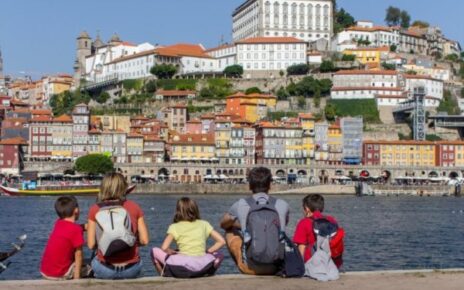Do NOT confuse the Montepulciano wine made from the varietal of the same name with Vino Nobile di Montepulciano.
Do Not Be Mistaken
Montepulciano wine is made from the Sangiovese grape variety (minimum of 70 percent), and the grapes must come from the hills surrounding the village.
Do NOT confuse Nobile di Montepulciano with Brunello. At the center of both wines is Sangiovese; however, Nobile di Montepulciano is made with the clone, Prugnolo Gentile, and Brunello relies on Sangiovese Grosso (100 percent).
Do NOT confuse Nobile di Montepulciano with Chianti, with unique soil types and micro-climates, expect more fruit and floral aromas in a Chianti, Chianti requires a minimum of 80 percent Sangiovese.
History
Vino Nobile is a small and distinctive appellation located approximately 65 km southeast of Siena. Viticulture in the region dates back many centuries to Etruscan times. During the 15th Century, the local wine was a favorite among the Sienese aristocracy and, in the 16th Century, it was valued by Pope Paul III, who spoke of the wine’s excellent qualities.
Montepulciano was first documented in a 1350 manuscript highlighting the marketing and export of wine. The Vino Nobile was officially noted in the 15th century when Poliziano (Angelo Ambrogini 1454-1494; Italian poet and humanist) took residence in the court of Lorenzo dei Medici. The nobles loved the wine and poet Francesco Redi called it the “King of all wines” in his book, Bacchus of Tuscany (17th century). King William III of England made it a personal favorite (1689-1702). The French writer, Voltaire, mentioned Nobile di Montepulciano in his book, Candide (1759). Even the third president of the United States, Thomas Jefferson (1801-1809), said it was “most superlatively good.”
The reputation of the wine was secured when, in 1933, it was determined to be an excellent product at the first wine commerce exhibition in Siena.
Adamo Fanetti is noted for naming the wine, Vino Nobile di Montepulciano and promoting the wine internationally in the years following World War I. In 1937 Fanetti started Cantina Sociale with the intention of marketing the wine internationally. Fanetti Vino Nobile was awarded a gold medal in 1937 at the Grand Prix de Paris. DOC status was granted in 1966 and DOCG in 1980.
Vino Nobile di Montepulciano appeared on the world market in 1983 as Italy’s first DOCG import. Over time, the 70-member Consorzio del Vino Nobile di Montepulciano has taken over control of production with adherence to a high standard of quality and identity, and the wine is now highly regarded internationally. The trend today is to produce lighter wines with less aggressive tannins; 12 producers (out of 74 wineries) are currently certified biodynamic with a movement toward renewable energy.
Characteristics of the Wine
Vino Nobile di Montepulciano is a red wine with a Denominazione di Origine Controllata e Garantita (DOCG) status. It is made with a minimum of 70 percent Sangiovese and blended with Canaiolo Nero (10-20 percent) and small amounts of other local varieties such as Mammolo. It is aged for 2 years (a minimum of 1 year in oak barrels); when aged for 3 years it is a reserve. Local winemakers frequently used large Italian botti (oak vessels with a larger capacity than a barrique with less surface area in relation to volume, rather than the smaller French barrels to avoid undesirable oak characters (vanilla, toast) in the wine.
Vino Nobile di Montepulciano can only be produced from the grapes harvested from the sloping vineyards surrounding the medieval town of Montepulciano. The wine is warm, sexy and soft, spicy, expressive of the individual terroirs, and the local grapes distinctively express the regional culture. Elegant, complex, and understated, an alluring perfume is detected as you lean into the glass.
When young, the wine is refreshing and easy to enjoy presenting vibrant flavors of cherry, plum strawberry, and dark ripe berries with a touch of earthiness and spice. As it matures, it presents a medium body, gentle tannins, and high acidity. Capable of aging for up to 20 years sips raise memories of tobacco, leather, and candied fruit. the wine presents maroon-red to the eye evolving to a subtle brick-orange tine over time. Characterized by dark cherry and plum aromas, ripe strawberry and cherry fruit flavors, and a gentle tannic tea-leaf finish.

Curated Wine Selection
1. 2019. Fattoria Svetoni. Vino Nobile di Montepulciano DOCG. Gracciano-Cervognano vineyard location. Sangiovese and other classic varieties of the denomination. Fermented in stainless steel and aged at least 18 months in oak. The vineyard started at the beginning of the 19th century in Montepulciano. It has been producing wines since 1865.
To the eye, dark ruby red. The aroma is a blend of cherries, black cherry, currants, raspberries, earth, wood, and herbs making it a unique and intriguing experience. On the palate, drying tannins. The wood of the barrique does not overwhelm and leads to a long dry finish.
2. 2019. Manvi. Arya. Vino Nobile di Montepulciano. Valardegna and Gracciano vineyard location. 100 percent Sangiovese, no yeast added. Aged in French oak barrels for 24 months, followed by a minimum of one year in the bottle. The fruits come from Manvi’s organic vineyards. Grapes are grown without chemical fertilizers, pesticides or herbicides.
To the eye, a brilliant garnet hue. The nose is delighted with the aroma of earth, dried fruit, ripe plums, wood, sage, and cardamon. Light, elegant, and full of flavor.
3. 2017. Podere Casa Al Vento. Nobile di Montepulciano. Vineyard location: Montepulciano. 100 percent Sangiovese. The grapes are harvested manually in late September/early October and transferred to the cellar for soft pressing. Aged 24 months in oak barrels of 20 hl. Podere Casa al Vento is a family-run vineyard located in Tuscany.
To the eye, ruby red to rust. The nose finds dark red fruit, plums, and hints of floral notes (think violets and lavender). The palate experience brings thoughts of wood, wet rocks, and very ripe strawberries. The structured tannins and acidity create a sophisticated taste experience.
© Dr. Elinor Garely. This copyright article, including photos, may not be reproduced without written permission from the author.





